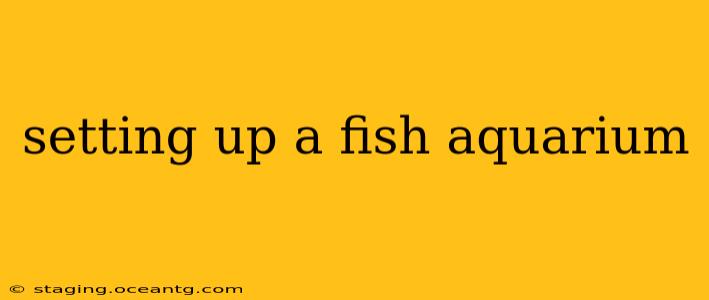Setting up a fish aquarium can be a rewarding experience, bringing a touch of nature and tranquility to your home. However, success requires careful planning and execution. This comprehensive guide will walk you through each step, ensuring your aquatic friends thrive in their new environment. From choosing the right tank to maintaining water quality, we'll cover everything you need to know to create a thriving underwater ecosystem.
What size aquarium should I get?
Choosing the right aquarium size is crucial. Consider the space you have available, your budget, and the types of fish you plan to keep. Larger tanks are generally easier to maintain stable water parameters and offer more swimming space for your fish. Smaller tanks require more frequent water changes. Beginners often find success with tanks in the 10-20 gallon range, which allows for a manageable bioload and variety of fish species. Research the adult size of your chosen fish to ensure they have enough room to grow.
What equipment do I need for a fish tank?
Essential equipment for a successful fish tank includes:
- Aquarium: Choose a tank made of high-quality glass or acrylic.
- Filter: A crucial component for maintaining water quality. Select a filter appropriate for your tank size.
- Heater: Most tropical fish require a heated environment. Choose a submersible heater with a thermostat.
- Substrate: This forms the base of your aquarium. Options include gravel, sand, or specialized substrates.
- Lighting: Essential for plant growth and the overall aesthetic of the tank. LED lighting is energy-efficient and widely available.
- Water Testing Kit: Regular water testing is vital for monitoring water parameters.
- Gravel Vacuum/Syphon: Used for cleaning the substrate and removing debris.
- Net: For safely catching fish during water changes or tank maintenance.
How do I cycle a fish tank?
Cycling a fish tank is a critical step, establishing beneficial bacteria that break down fish waste, ammonia, and nitrite, converting them into less harmful nitrate. This process usually takes several weeks and involves establishing a nitrogen cycle. Skipping this step can lead to ammonia poisoning and fish death. There are several methods, including the fishless cycle (recommended for beginners) and the fish-in cycle (more risky). Research these methods thoroughly before proceeding.
What kind of fish are good for beginners?
Several hardy fish species are ideal for beginner aquarists. These fish are generally tolerant of minor water parameter fluctuations and less demanding in terms of care. Popular choices include:
- Harlequin Rasboras: Small, peaceful schooling fish.
- Neon Tetras: Another popular schooling fish known for their vibrant colors.
- Platies: Live-bearing fish that are relatively easy to care for.
- Guppies: Similar to platies, they are hardy and come in a variety of colors.
- Corydoras Catfish: Bottom-dwelling fish that help clean up leftover food.
Remember to research the specific needs of any fish you choose before purchasing them to ensure compatibility with your tank and other inhabitants.
How often should I clean my fish tank?
Regular maintenance is key to a healthy aquarium. This includes:
- Partial Water Changes: Aim for 25-50% water changes weekly, depending on your tank size and bioload.
- Substrate Cleaning: Use a gravel vacuum to remove debris and uneaten food from the substrate.
- Filter Maintenance: Rinse the filter media in old aquarium water (not tap water) regularly to prevent clogging.
- Algae Removal: Manually remove algae as needed using an algae scraper or cleaning magnet.
What are the common problems with fish tanks?
Several common issues can arise in fish tanks:
- Green Water: This is often caused by an algae bloom, often related to excessive light or nutrients.
- Cloudy Water: This can be caused by several factors including overfeeding, bacterial blooms, or a poorly cycled tank.
- Fish Disease: Observe your fish regularly for signs of disease and consult a veterinarian specializing in aquatic animals if necessary.
Addressing these problems promptly is crucial to maintaining a healthy aquarium environment.
How much does setting up a fish aquarium cost?
The cost of setting up a fish aquarium varies considerably depending on the size of the tank, the equipment chosen, and the type of fish you select. You can expect to spend anywhere from a few hundred dollars for a small, basic setup to several thousand dollars for a larger, more sophisticated system. Factor in ongoing costs for fish food, water testing kits, and occasional equipment replacements.
By following these guidelines and conducting thorough research, you can set up a thriving and beautiful fish aquarium, providing a happy and healthy home for your aquatic companions. Remember patience and diligent maintenance are key to success.
